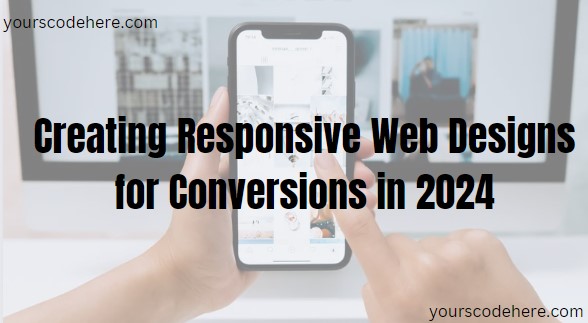In today’s digital landscape, responsive web design is pivotal for engaging users and driving conversions. This guide explores actionable strategies to create responsive designs that prioritize user experience and maximize conversion rates.
1. Understanding Responsive Web Design:
a. Responsive vs. Adaptive: Differentiate between responsive and adaptive design, focusing on responsiveness that seamlessly adapts to various devices and screen sizes.
b. Mobile-First Approach: Embrace a mobile-first mindset, prioritizing design elements and functionalities for mobile devices, ensuring a smooth user experience across all platforms.
2. User-Centric Design Principles:
a. Intuitive Navigation: Implement clear and intuitive navigation, simplifying user journeys and ensuring easy access to essential content or conversion points.
b. Readable Typography: Opt for readable font styles and sizes, ensuring legibility across devices without compromising the visual appeal of the content.
3. Visual Elements for Conversions:
a. Strategic Call-to-Actions (CTAs): Place compelling CTAs strategically, employing contrasting colors and persuasive copy to prompt user actions.
b. Visual Hierarchy: Employ visual hierarchy to emphasize important content, guiding users’ attention towards conversion-driving elements.
4. Optimizing Performance for Conversions:
a. Speed and Loading Times: Optimize website loading speed by minimizing file sizes, leveraging caching techniques, and using efficient coding practices.
b. Mobile Optimization: Ensure swift and seamless experiences on mobile devices by optimizing images, using responsive layouts, and minimizing redirects.
5. Testing and Iterating:
a. A/B Testing: Conduct A/B tests for different design elements, CTAs, or layouts to identify what resonates best with your audience for improved conversions.
b. User Feedback Integration: Collect user feedback through surveys, heatmaps, or user testing to iterate and refine design elements based on user preferences.
6. SEO-Friendly Responsive Designs:
a. Mobile-Friendly Ranking Factors: Ensure adherence to Google’s mobile-friendly criteria for better search rankings and improved visibility.
b. Structured Data Implementation: Leverage structured data to enhance search engine understanding of your site’s content and improve visibility in SERPs.
7. Analytics and Conversion Tracking:
a. Implementing Analytics Tools: Integrate tools like Google Analytics to track user behavior, analyze conversion funnels, and identify optimization opportunities.
b. Conversion Funnel Analysis: Analyze conversion funnels to pinpoint potential drop-off points and optimize design elements for smoother user journeys.
8. Continuous Iteration and Improvement:
a. Data-Driven Decisions: Base design changes on collected data and user feedback, continually iterating to enhance user experience and boost conversions.
b. Staying Updated: Keep abreast of design trends, technology advancements, and user preferences to adapt and optimize your website for ongoing success.
Conclusion:
Creating responsive web designs optimized for conversions involves a harmonious blend of user-centric design, performance optimization, and iterative improvements. By implementing these strategies and continually refining your approach, you can craft a compelling, responsive web presence that fosters enhanced user engagement and drives conversions.










